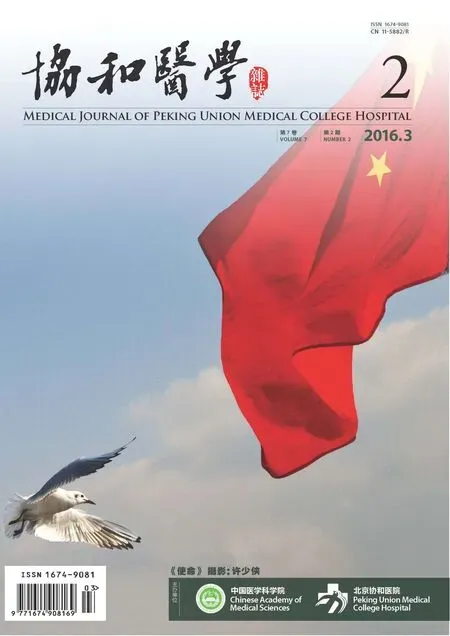肺大细胞神经内分泌癌手术治疗及预后因素
2016-03-30陈野野李单青田震寰周小昀刘洪生
陈野野,李单青,田震寰,周小昀,何 嘉,张 晔,刘洪生
中国医学科学院 北京协和医学院 北京协和医院胸外科,北京100730
肺大细胞神经内分泌癌手术治疗及预后因素
陈野野,李单青,田震寰,周小昀,何 嘉,张 晔,刘洪生
中国医学科学院 北京协和医学院 北京协和医院胸外科,北京100730
目的 探讨肺大细胞神经内分泌癌 (large cell neuroendocrine carcinoma,LCNEC)的临床特点及手术治疗经验并分析相关预后因素。方法 2000年1月至2014年1月在北京协和医院诊治并经手术病理证实为LCNEC的患者35例,其中男性29例,女性6例,回顾性总结其临床资料,分析以手术为主综合治疗的结局并分析相关预后因素。结果 35例患者就诊时中位年龄为63岁 (47~77岁),中位病程为2个月 (1~14个月)。临床症状不具特异性,术前活检病理难以明确诊断。手术方法根据肿瘤具体情况采用开胸或胸腔镜下肺叶切除及淋巴结清扫。术后病理分期Ⅰ期12例,Ⅱ期7例,Ⅲ期13例,Ⅳ期3例。23例患者行辅助治疗。患者中位生存期17个月 (95%CI:11.4~22.6),1、3、5年生存率分别为60.6%、29.0%、24.8%。肿瘤分期对LCNEC患者生存期存在显著影响 (Cox多因素分析HR 2.608,95%CI:1.572~4.327,P=0.000)。结论 LCNEC为一种罕见的侵袭性强、预后差的恶性肿瘤,分期是影响其预后的独立危险因素,对于早期病变尤其是Ⅰ、Ⅱ期病变采用手术为主的综合治疗可获得较好的治疗效果。
神经内分泌癌;肺;手术治疗;预后
Med J PUMCH,2016,7(2):98-103
肺大细胞神经内分泌癌 (large cell neuroendocrine carcinoma,LCNEC)最早见于1989年的病例报道[1],后由Travis等[2]于1991年首次行病例总结,随着认识的不断深入,目前将其列为不同于典型类癌、不典型类癌以及小细胞神经内分泌癌的一类新型肺部神经内分泌癌[3]。目前认为,LCNEC为一种罕见的、侵袭性强、预后相对较差的肺部神经内分泌癌[4-5]。由于该病认识时间尚短,且为罕见疾病,目前还缺乏诊治经验及指南。本文回顾性分析北京协和医院近15年经手术病理证实的35例LCNEC病例资料,旨在总结以手术为主的综合治疗疗效,并分析潜在的预后因素。
资料和方法
资料
收集2000年1月至2014年1月在北京协和医院诊治、术前评估为可切除病灶并经手术病理证实为LCNEC的患者资料。对所有患者临床症状、影像学检查、手术与综合治疗方式及结局进行分析。
治疗方法
对患者采取以手术为主的综合治疗。手术方法根据肿瘤的部位、大小、位置等具体情况不同而采用开胸或胸腔镜下肺叶切除+肺门纵隔淋巴结清扫。肿瘤分期参考肺癌TNM分期[6-7]。
统计学处理
应用SPSS 19.0软件进行数据分析,符合正态分布的计量资料采用均数±标准差表示,非正态分布资料采用中位数表示。应用 Kaplan-Meier生存曲线及Log-rank单因素检验分析生存时间及预后相关因素。生存期计算为自手术日期到患者死亡或末次随诊日期的时间。选择年龄 (中位年龄为界)、性别、病变部位、TNM分期 (Ⅰ、Ⅱ期为一组,Ⅲ、Ⅳ期为一组)以及是否接受辅助治疗等变量因素,应用Log-rank检验进行单因素分析其对生存期是否存在影响,并将单因素分析中P<0.5的变量带入Cox回归模型行多因素分析。以P<0.05为差异有统计学意义。
结果
一般情况
2000年1月至2014年1月经北京协和医院术后病理证实为LCNEC的患者共35例,其中男性29例,女性6例 (男∶女=4.8∶1),中位年龄63岁,就诊时中位病程2个月。35例患者中28例 (80%)有吸烟史,其中男性吸烟率高达96.6%(28/29),而6例女性患者均不吸烟 (表1)。

表1 35例肺大细胞神经内分泌癌患者临床资料
临床表现及检查
患者主要临床表现有咳嗽、咳痰、胸背痛、胸闷、发热等,无症状查体发现者9例 (25.7%)。CT检查考虑周围型病变21例 (图1),中心型病变14例 (表1)。中心型病变中11例行支气管镜检查均可见新生物,活检病理:小细胞肺癌 (small cell lung cancer,SCLC)1例,非小细胞肺癌 (non-small cell lung cancer,NSCLC)1例,低分化癌3例,中分化鳞癌1例,低分化腺癌1例,腺鳞癌1例,可见癌细胞1例,坏死2例。周围型病变3例行支气管镜检查未见异常,1例经CT引导下穿刺病理考虑分化差的癌。
术前辅助治疗
4例患者行术前辅助治疗:1例为术前活检病理考虑SCLC,术前2程化疗 (卡铂+VP16方案),病变缩小后行手术治疗;1例术前活检病理可见癌细胞未分型,患者因临床评估Ⅲ期,术前化疗4程 (长春瑞滨+顺铂)并联合放疗,病变缩小后手术;1例术前活检病理考虑NSCLC,术前2程化疗 (紫杉醇+顺铂),病变变化不明显后手术;还有1例术前活检病理为低分化腺癌,术前化疗2程 (替加氟+卡铂),病变变化不明显后手术。
手术方式及术后情况
患者手术方式为:肺叶切除及淋巴结清扫24例,复合肺叶切除及淋巴结清扫5例,袖式肺叶切除及淋巴结清扫3例,亚肺叶切除 (肺楔形切除或肺段切除)及淋巴结清扫3例 (其中楔形切除2例,解剖性肺段切除1例)(表1)。胸腔镜手术4例,开胸手术31例。围术期死亡1例 (2.8%),因呼吸功能衰竭于术后37 d死亡;围术期并发症2例 (5.7%),均为术后脑梗死,经治疗后好转。
手术病理结果
肿瘤的中位最大径为4.0 cm(1.2~12.0 cm)。手术中送冰冻病理检查8例,6例报告肺癌未分型,1例低分化神经内分泌癌,1例可能为神经内分泌癌。最终35例均由石蜡病理及免疫组织化学确认为LCNEC。TNM分期为Ⅰ期12例 (Ⅰa期5例,Ⅰb期7例),Ⅱ期7例 (Ⅱa期2例,Ⅱb期5例),Ⅲ期13例 (Ⅲa期10例,Ⅲb期3例),Ⅳ期3例(表1)。

图1 肺大细胞神经内分泌癌周围型病变CT示分叶状结节或肿块,边界尚清,存在短毛刺及胸膜牵拉征
术后治疗及随访
35例患者中1例于围术期死亡,34例术后中位随访时间16.5个月 (5~135个月)。12例患者术后未进行辅助治疗,其中除1例于围术期死亡外,6例死于术后肿瘤进展,1例肿瘤复发带瘤生存,4例无瘤生存。23例患者行辅助治疗,辅助治疗中化疗均是以铂类为基础的化疗方案,其中5例无瘤生存,18例死于肿瘤进展。肿瘤进展多为转移性复发,复发部位主要为骨、脑、淋巴结 (锁骨上及纵隔为主)。采用Kaplan-Meier法计算生存期,中位生存期仅17个月 (95%CI:11.4~22.6),1年、3年、5年生存率分别为60.0%、29.0%、24.8%(图2)。
预后因素分析结果
应用Log-Rank单因素分析方法对性别、年龄、病变部位、肿瘤分期及是否行辅助治疗这些可能对生存期产生影响的因素进行分析,结果提示病变部位 (周围型比中心型,P=0.030)及肿瘤分期 (Ⅰ、Ⅱ期比Ⅲ、Ⅳ期,P=0.000)可能是影响预后的因素;而性别 (男比女,P=0.875)、年龄 (>中位年龄比≤中位年龄,P=0.588)、是否行辅助治疗 (P=0.363)未发现对生存期有明显影响。进一步将P<0.5的变量,包括病变部位、肿瘤分期及是否行辅助治疗带入Cox多因素模型分析,发现仅肿瘤分期对预后存在显著影响 (P=0.000)(表2)。

图2 肺大细胞神经内分泌癌患者Kaplan-Meier生存曲线

表2 肺大细胞神经内分泌癌患者预后因素的Cox多因素分析结果
讨论
2004年,新的WHO病理分型将肺部神经内分泌癌分为分化好的神经内分泌癌即典型类癌与不典型类癌,以及分化差的神经内分泌癌即小细胞神经内分泌癌以及大细胞神经内分泌癌[3]。随着组织学诊断技术尤其是免疫组织化学神经内分泌标志物的发展,越来越多的肺部神经内分泌肿瘤得到诊断并分型,也是近年来肺部神经内分泌肿瘤发病率不断增高的原因之一[8-9]。目前已经认识到典型类癌与不典型类癌预后相对较好,SCLC通常预后极差,而对于LCNEC则认识不足[10]。多数文献报道LCNEC较同期别NSCLC侵袭性更强、预后更差,5年生存率15% ~60%[4,11-13],已有学者将其列为与SCLC一样预后极差的肺部恶性肿瘤。
本组患者男性占82.8%,吸烟率高达80%,中位年龄63岁,与文献报道的男性患者80%~90%的比例,吸烟率大于85%,中位年龄62~68岁相近[14-18]。另外,与类癌、不典型类癌以及SCLC不同,LCNEC病变部位以周围型病变为主,本组占60%,与文献报道的2/3符合。由于LCNEC临床症状相对少见且缺乏特异性,因此影像学检查尤其胸部CT是发现病变的重要检查手段[12-13]。文献报道LCNEC周围型病变的CT表现为分叶状结节或肿块,边界尚清,与扩张性生长的周围型 SCLC、低分化腺癌、鳞癌等类似[19-20]。图1示本组1例周围型病变CT图像,表现为分叶生长的实性结节,可见毛刺及明显的胸膜牵拉征。
术前诊断LCNEC存在较大困难,有文献报道肿瘤标志物中癌胚抗原及胃泌素释放前肽有一定提示意义,但敏感性及特异性都不高[14];另外,即使应用免疫组织化学分子标记,术前活检获取小标本对LCNEC的诊断率也极低[4,11,21]。本组中12例活检无一确诊,术中冰冻病理也很难判断。由于免疫组织化学标记、细胞形态学、核分裂象等是神经内分泌肿瘤定性及分型的重要指标,因此LCNEC的诊断基本上均需在术后病理切片仔细判读的基础上才能明确。而在较小的穿刺标本上,神经内分泌肿瘤形态判别及免疫组织化学判读均存在很大困难[11,22]。正因如此,对于怀疑LCNEC的患者手术指征应适当放宽,甚至在怀疑存在转移的情况下,有时也需考虑应用手术方式来获取足量的病变组织以明确诊断,术后才能更有针对性地进行辅助治疗。
对于可切除的LCNEC,文献报道其预后差异较大,5年生存率为15%~60%,即使为I期患者,5年生存率差异也很大 (18% ~88%),可能原因是LCNEC为罕见病,多数文献都是小规模病例报告,而且以往对LCNEC认识有限、免疫组织化学手段缺乏,存在诊断不准确的可能性[4,11]。本组患者中位生存期17个月 (95%CI:11.4~22.6),5年生存率仅24.8%,其中Ⅰ期患者5年生存率为71.3%,Ⅰ、Ⅱ期患者5年生存率可达49.9%,提示对于早期LCNEC患者,手术为主的综合治疗可以达到较好的治疗效果。既往对LCNEC预后相关因素的研究显示,年龄、性别、进展期、手术方式等都不是相关的预后因素[16-17]。本研究尝试对性别、年龄、病变部位、肿瘤分期、是否行辅助治疗等因素进行分析,最终经多因素分析显示肿瘤分期是该病独立的预后因素,Cox回归模型HR= 2.6,提示分期每提高一期其死亡风险较前一期增加1.6倍。另外还有研究对核分裂象、Ki-67指数、免疫组织化学指标等因素作预后分析[4,23-24],但尚未得出明确结论。
目前有很多研究都提出LCNEC与SCLC临床特征十分相近,如均以男性患者为主、多数患者吸烟、组织病理学表现较为近似、恶性程度均很高且预后均很差等。Asamura等[14]于2006年报道一项大宗肺神经内分泌癌回顾性研究,共纳入141例患者,LCNEC与SCLC 5年生存率十分接近,分别为40%及36%;而另有多个研究也报道,LCNEC的5年生存率与SCLC相近甚至更差[25-28]。因此,有研究者认为SCLC的化疗方案可能也适用于LCNEC。已有较多研究表明采用SCLC的化疗方案即顺铂联合依托泊苷对于LCNEC的治疗效果优于采用NSCLC的化疗方案,顺铂联合依托泊苷已越来越多地用于治疗LCNEC,且鉴于LCNEC较高的恶性程度以及较高的复发率,建议早期患者也采用术后辅助治疗[11,29-30]。由于以往对LCNEC的认识均来自单中心、小样本回顾性研究,缺乏相应的指南,本组患者中行化疗者其方案并不统一,多数是以铂类药物为基础联合另一药物治疗,包括依托泊苷、长春瑞滨、多西他赛等,因此本研究中辅助治疗对预后影响的判定可能存在偏倚,需要将来积累更多数据以得出准确结论。
综上,LCNEC为一种罕见的侵袭性强、预后差的恶性肿瘤,活检小标本诊断存在困难,诊断依赖术后病理。分期是影响预后的独立危险因素,对于早期病变尤其是Ⅰ、Ⅱ期病变采用手术为主的综合治疗可获得较好的治疗效果。辅助化疗方案可借鉴SCLC的方案即顺铂联合依托泊苷。由于疾病的罕见性,目前还缺乏基于临床试验的诊治指南,需要积累更多病例及多中心研究以进一步探讨。
[1]Barbareschi M,Mariscotti C,Barberis M,et al.Large cell neuroendocrine carcinoma of the lung[J].Tumori,1989,75: 583-588.
[2]Travis WD,Linnoila RI,Tsokos MG,et al.Neuroendocrine tumors of the lung with proposed criteria for large-cell neuroendocrine carcinoma.An ultrastructural,immunohistochemical,and flow cytometric study of 35 cases[J].Am J Surg Pathol,1991,15:529-553.
[3]Travis WD,Brambilla BE,Müller-Hermelink,et al.Pathology and Genetics of Tumours of the Lung,Pleura,Thymus and Heart(WHO Classification of Tumours)[M].Lyon:IARC Press,2004:145-247.
[4]Eichhorn F,Dienemann H,Muley T,et al.Predictors of survival after operation among patients with large cell neuroendocrine carcinoma of the lung[J].Ann Thorac Surg,2015,99: 983-989.
[5]Iyoda A,Makino T,Koezuka S,et al.Treatment options for patients with large cell neuroendocrine carcinoma of the lung[J].Gen Thorac Cardiovasc Surg,2014,62:351-356.
[6]Lababede O,Meziane M,Rice T.Seventh edition of the cancer staging manual and stage grouping of lung cancer:quick reference chart and diagrams[J].Chest,2011,139:183-189.
[7]Travis WD,Giroux DJ,Chansky K,et al.The IASLC Lung Cancer Staging Project:proposals for the inclusion of bronchopulmonary carcinoid tumors in the forthcoming(seventh)edition of the TNM Classification for Lung Cancer[J].J Thorac Oncol,2008,3:1213-1223.
[8]Gridelli C,Rossi A,Airoma G,et al.Treatment of pulmonary neuroendocrine tumours:state of the art and future developments[J].Cancer Treat Rev,2013,39:466-472.
[9]Phan AT,Oberg K,Choi J,et al.NANETS consensus guideline for the diagnosis and management of neuroendocrine tumors:well-differentiated neuroendocrine tumors of the thorax (includes lung and thymus)[J].Pancreas,2010,39: 784-798.
[10]Travis WD.Advances in neuroendocrine lung tumors[J].Ann Oncol,2010,21 Suppl 7:65-71.
[11]Sakurai H,Asamura H.Large-cell neuroendocrine carcinoma of the lung:surgical management[J].Thorac Surg Clin,2014,24:305-311.
[12]Glisson BS,Moran CA.Large-cell neuroendocrine carcinoma: controversies in diagnosis and treatment[J].J Natl Compr Canc Netw,2011,9:1122-1129.
[13]Paci M,Cavazza A,Annessi V,et al.Large cell neuroendocrine carcinoma of the lung:a 10-year clinicopathologic retrospective study[J].Ann Thorac Surg,2004,77:1163-1167.
[14]Asamura H,Kameya T,Matsuno Y,et al.Neuroendocrine neoplasms of the lung:a prognostic spectrum[J].J Clin Oncol,2006,24:70-76.
[15]Grand B,Cazes A,Mordant P,et al.High grade neuroendocrine lung tumors:pathological characteristics,surgical management and prognostic implications[J].Lung Cancer,2013,81:404-409.
[16]Veronesi G,Morandi U,Alloisio M,et al.Large cell neuroendocrine carcinoma of the lung:a retrospective analysis of 144 surgical cases[J].Lung Cancer,2006,53:111-115.
[17]Sarkaria IS,Iyoda A,Roh MS,et al.Neoadjuvant and adjuvant chemotherapy in resected pulmonary large cell neuroendocrine carcinomas:a single institution experience[J].Ann Thorac Surg,2011,92:1180-1186.
[18]Iyoda A,Hiroshima K,Moriya Y,et al.Postoperative recurrence and the role of adjuvant chemotherapy in patients with pulmonary large-cell neuroendocrine carcinoma[J].J Thorac Cardiovasc Surg,2009,138:446-453.
[19]Shin AR,Shin BK,Choi JA,et al.Large cell neuroendocrine carcinoma of the lung:radiologic and pathologic findings[J].J Comput Assist Tomogr,2000,24:567-573.
[20]Akata S,Okada S,Maeda J,et al.Computed tomographic findings of large cell neuroendocrine carcinoma of the lung[J].Clin Imaging,2007,31:379-384.
[21]Maleki Z.Diagnostic issues with cytopathologic interpretation of lung neoplasms displaying high-grade basaloid or neuroendocrine morphology[J].Diagn Cytopathol,2011,39:159-167.
[22]Fernandez FG,Battafarano RJ.Large-cell neuroendocrine carcinoma of the lung:an aggressive neuroendocrine lung cancer[J].Semin Thorac Cardiovasc Surg,2006,18:206-210.
[23]Faggiano A,Sabourin JC,Ducreux M,et al.Pulmonary andextrapulmonary poorly differentiated large cell neuroendocrine carcinomas:diagnostic and prognostic features[J].Cancer,2007,110:265-274.
[24]Takei H,Asamura H,Maeshima A,et al.Large cell neuroendocrine carcinoma of the lung:a clinicopathologic study of eighty-seven cases[J].J Thorac Cardiovasc Surg,2002,124:285-292.
[25]Battafarano RJ,Fernandez FG,Ritter J,et al.Large cell neuroendocrine carcinoma:an aggressive form of non-small cell lung cancer[J].J Thorac Cardiovasc Surg,2005,130: 166-172.
[26]Iyoda A,Travis WD,Sarkaria IS,et al.Expression profiling and identification of potential molecular targets for therapy in pulmonary large-cell neuroendocrine carcinoma[J].Exp Ther Med,2011,2:1041-1045.
[27]Isaka M,Nakagawa K,Ohde Y,et al.A clinicopathological study of peripheral,small-sized high-grade neuroendocrine tumours of the lung:differences between small-cell lung carcinoma and large-cell neuroendocrine carcinoma[J].Eur J Cardiothorac Surg,2012,41:841-846.
[28]Kinoshita T,Yoshida J,Ishii G,et al.The differences of biological behavior based on the clinicopathological data between resectable large-cell neuroendocrine carcinoma and small-cell lung carcinoma[J].Clin Lung Cancer,2013,14:535-540.
[29]Sun JM,Ahn MJ,Ahn JS,et al.Chemotherapy for pulmonary large cell neuroendocrine carcinoma:similar to that for small cell lung cancer or non-small cell lung cancer?[J].Lung Cancer,2012,77:365-370.
[30]Iyoda A,Hiroshima K,Moriya Y,et al.Prospective study of adjuvant chemotherapy for pulmonary large cell neuroendocrine carcinoma[J].Ann Thorac Surg,2006,82:1802-1807.
Large Cell Neuroendocrine Carcinoma of the Lung:Outcomes after Surgical Resection and Prognostic Factors
CHEN Ye-ye,LI Shan-qing,TIAN Zhen-huan,ZHOU Xiao-yun,HE Jia,ZHANG Ye,LIU Hong-sheng
Department of Thoracic Surgery,Peking Union Medical College Hospital,Chinese Academy of Medical Sciences&Peking Union Medical College,Beijing 100730,China
LI Shan-qing Tel:010-69154038,E-mail:pumchlsq@163.com
Objective To investigate the clinical manifestations,outcomes after surgical management,and prognostic factors of large cell neuroendocrine carcinoma(LCNEC)of the lung.Methods We retrospectively analyzed the data of 35 consecutive cases(29 males,6 females)of LCNEC of the lung surgically treated and pathologically confirmed in Peking Union Medical College Hospital from January 2000 to January 2014.Their outcomes after receiving surgery-based comprehensive therapy and related prognostic factors were explored.Results The median age of patients was 63(47-77)years and the median duration of disease was 2(1-14) months.No specific symptom was found and preoperative pathological diagnosis was not definitive.Surgical methods included open or thoracoscopic lobectomy and lymph node dissection based on the specific conditions of tumor in each case.Postoperative pathological staging showed stageⅠin 12 cases,stageⅡin 7,stageⅢin 13,and stageⅣin 3.Twenty-three patients received adjuvant therapy.Median survival was 17 months[95%confidence interval (CI):11.4-22.6 months].The 1-year,3-year,and 5-year survival rates were 60.6%,29.0%,and 24.8%,respectively.Tumor stage was significantly related with the overall survival(Cox regression analysis,hazard ration=2.608,95%CI:1.572-4.327,P=0.000).Conclusions LCNEC is a rare malignancy with tremendous aggressiveness and poor prognosis.Stage of tumor may be the independent risk factor affecting the prognosis.Surgerybased comprehensive therapy could achieve good survival for patients of early stages,especially stagesⅠandⅡ.
neuroendocrine carcinoma;lung;surgery;prognosis
李单青 电话:010-69154038,E-mail:pumchlsq@163.com
R734.2
A
1674-9081(2016)02-0098-06
10.3969/j.issn.1674-9081.2016.02.004
2015-06-10)
